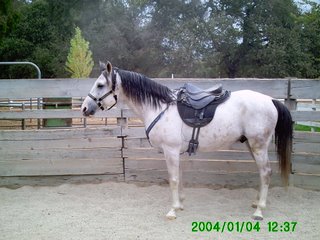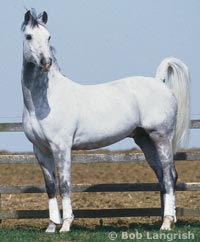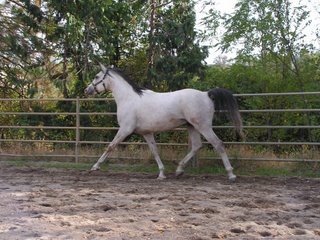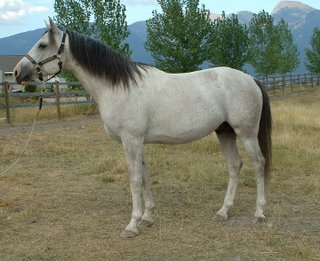This is a video of Erik at Oak Tree Farms just before I brouht him home
Thursday, November 30, 2006
Sunday, November 05, 2006
Erik at the Ranch
On Monday Erik came home to the ranch. Michele Roush was at Oak Tree Farms when I went to load Erik, she gently tapped him with a leaf rake until he jumped into the trailer. Prior to the trailer I needed to have a vet measure Erik for a listing in a German stud book. He measured 16 hands barefoot, 8 7/8" cannon bones, and a 74" girth.
Once at the Ranch he was put into his new corral. All 6 of the other boys came running to visit. It was kind of scary as they screamed and kicked at each other through the corral panels. Withing a few minutes all was fine.
On Tuesday I saddled up but no way he was going to let me get on. We walked for two miles doing the one rein stop while I tried to keep him still enough to get on, which I finally did. We then rode for another 2 miles.
We ended up with 24 miles for the week. He improved 100 percent everyday. We trotted and cantored and walked some hills. He mostly recovered to 60 in 10 min upon our return.
His lowest Heart Rate pre ride was 30 BPM. Highest was 205, but only for a few seconds. He seems to be able to trot on level ground in the mid to high 90's.
On Thursday he had size 2 shoes put on both front and rear. This made a big difference as I think his feet were a little sore. He seemed to move out much betteron the gravel roads he has to travel.
So far so good. He is pretty much unflapable on the trail. Goes through brush, over logs, nothing seems to phase him. He even stepped into the mud at the edge of the lake without protest.
Longest ride was 6.5 miles and shortest was 4 miles and he had thursday off as it rained and he had his shoes put on.
Friday, October 20, 2006
First Ride
Today Erik went for his first ride with me abord in the round pen. We have spent the last few weeks doing ground work, most the time with the saddle on. The last few days we work on me getting up into the saddle, first one side and then the other, just laying across the saddle, and some slow walking. His first responce to the saddle a few weeks ago was to have a bucking tizzy fit so we took a little more time with the ground work.
I have to say that he has been a perfect gentlemen and everyone has fallen in love with him.
Wednesday, October 04, 2006

Because of a case of Pigeon fever at home Erik is going to stay at the boarding facalities close to my ranch. I usually visit twice a day. In the morning he does 2.5 miles in the round pen and 1 mile or so in the larger arena in the afternoon.
Erik is sporting a FreeWest treeless saddle without the stirrups. On board GPS gives us our milage and speed, Polar downloadable Heart Rate transmitter gives us his Heart Rate every few seconds. Good for evaluating recoveries.
Saturday, September 30, 2006
Had my first visit with Erik today. I was quite pleased. When I got to the stable where I am going to keep him for a week or so he was in the round pen. I had some horse cookies with me. He walked right up to me and started sniffing. I was his best buddy after he found the cookies.
I put a halter on him and worked on his feet for awhile. Had no problem putting his feet on the stand and letting me work the file taking off the flares, doing a slight mustang roll and lowering the heals a little. Will work more on them tomorrow.
Erik then got to go into a rather large arena where he was turned loose where he really cut loose. You could tell instantly that he is a real athelete by the way he moved around the arena with very smooth transitions from trot to cantor.
Monday, September 25, 2006
Leaving for Grass Valley, CA at 6am on 9/25/06
Buying a horse over the internet gives you lots of time to think about if "you have done the right thing" Even though I have had some expert help in evaluating gates, looking at conformation, xrays etc.. when you have not seen the horse in person you still have that hole in your stomach feeling. As I was looking for transportation for Erik back to my ranch I recieved the following email....
Chris, Small, small world! The trainer (Malika) is also a very good friend of mine. I take lessons from her in the winter when I have time. She is the one that called me on this horse last spring so I went to look at him from her recommendation. I was actually looking at him for Valerie Kanavy but she thought he was too big (she didn't see him, just pictures and from what I said). I told Doris he was a very nice horse, and may be suited for endurance. Although I wasn't sure at the World level because of his size but there are so many unknowns with horses that you don'tknow till several years down the road. He is very athletic, graceful, and just an impressive looking fella. Very nice disposition too. Did you have Leroy vet him (I worked for him for over 18 years and still take my horses over there-150 miles from me!)? If Leroy vetted him, he is probably the best vet I have ever been around in all my travels. Really knows what he's doing. Keep me posted on his progress.
Suzanne
The vet that did your pre-purchase on Erik was Leroy Hoversland, DVM andhe was the vet I worked for many years ago (and whom I still use for myendurance horses). He is excellent so you can have confidence on his findings. I have some pictures I took of Erik and have sent one of them along. I have several more of his feet, legs, etc. Again, good luck and keep me posted on his progress.
Suzanne
These emails from Susanne made my day..............................................................
Monday, August 28, 2006

BREED DESCRIPTION
By E.F. Watkins
You know horses, and you could swear you're looking at an Arabian. But there's something about this one, however, that's a little different. He has the same small, chiseled head, the graceful, curved neck, the somewhat short back and the high, proud tail carriage. Still, he's tall for an Arabian, bigger-boned and more substantial. He's a beautiful horse, but what is he? Some kind of cross, perhaps?
If you've never seen a Shagya before, you have plenty of company. This striking animal is still rare in the United States, where there are only about 20 active breeders of purebred Shagyas. They make up a passionate group, however, and are eager to enlighten their fellow Americans about the horse's sporting potential and long, colorful history.
The wellspring for purebred Shagya Arabians is still Babolna, Hungary. Founded in 1789, the Babolna stud originally produced high-quality horses for the formidable Austro-Hungarian cavalry, and many of the early broodmares had served as army horses. In 1816, the stud began injecting new blood by importing purebred Arabian stallions of desert breeding and crossing them with Arabian-looking mares that had Hungarian, Spanish or Thoroughbred blood.
The Arabian stallion Shagya came to Babolna from Syria in 1836. Descended from the Koheilan/Siglavy strain, Shagya was big for an Arabian — almost 16 hands — and was a distinctive cream color. He stood at Babolna until 1842, during which time he founded a breed all his own. His male descendants continue the Shagya dynasty today at studs all over Europe.
At the end of World War II, General George S. Patton brought about 20 Shagyas, along with other "rescued" European horses, from Czechoslovakia to the United States. The Shagyas were officially classified as "Arab kind," because the Americans did not recognize them as a special breed.
Three mares ended up on the 30,000-acre Montana farm of Countess Margit Bessenyey, granddaughter of Marcus Daly, the Anaconda Copper Company tycoon, and daughter of a Hungarian count. The countess acquired the horses in an attempt to preserve her Hungarian heritage. She ended up breeding only one pure Shagya, the stallion Hungarian Bravo, who was registered with the Hungarian Horse Association that she founded in 1966.
When the countess died in 1985, Bravo was 24. Her will specified that 22 of her older horses be put down humanely, because she feared they would fall into abusive hands. Bravo would have died this way, and the breed would have been wiped out in this country, if not for the efforts of Montana horsewoman Adele Furby. Furby, originally a breeder of Arabians and half-Arabians, had visited the Bessenyey ranch and developed a fascination with the Shagya. When she heard about Bravo's impending doom, she asked some locals to intercede in her favor so that she could buy the stallion.
Coming to America
Once she had him, she wrote to the Purebred Shagya Society International (ISG) for more information. The group sent back word that it wanted Bravo to be the foundation stallion in the United States. Furby got the organization's approval to breed a few Arabian mares to Bravo. She also imported six more Shagyas, single-handedly reviving the breed in America. In 1986, she founded the North American Shagya-Arabian Society (NASS) as a member organization of the ISG and established stud books in this country for both Shagyas and part-Shagyas.
Bravo survived to age 28, and by that time Furby had enough of his offspring to carry on the line. Bred to eb used for riding and driving, the Shagya still derives largely from desert-Arabian-influenced, Eastern European breeds; carefully selected desert Arabian stallions are occasionally used to improve the strain.
"The breed was consolidated many generations ago, so that it consistently breeds true to type," says Furby. "The Shagyas combine the advantages of the Bedouin Arabian — elegant type, great hardiness and toughness, endurance, easy-keeping qualities and inborn friendliness to humans &3151; with the requirements of a modern riding horse — sufficient height, big frame and great 'rideability,' including excellent movement and jumping ability."
The Shagya MissionThe breeding goal, as stated by the ISG, is that "the Shagya should be beautiful and harmonious, with an expressive head and well-formed neck, a good topline, a long pelvis, a well-carried tail and strong, dry, correct legs. Free, springy, elastic and correct action in all there gaits is very important. Wither height should be at least 15 or 16 hands, and cannon bone circumference should be a minimum of 7 inches. The Shagya should be physically and mentally capable of being a completely efficient and superior family, leisure, competition, hunting and endurance horse."
Furby admits this is an ambitious goal, but one she and other breeders strive to attain. "The European warmblood breeds are quality-controlled this way in both Europe and America," she says. "The NASS is attempting to maintain a similar system."
Dr. Michael Foss of White Salmon, Washington, met his first Shagya about eight years ago on his veterinary rounds. He treated one for a client and found it "a nice horse to work with." Soon he purchased some mares from Furby and began his own breeding establishment. Today he is president of the NASS.
"I thought they were a nice, sensible horse," he says. "Also, the inspection process they have to go through for breeding approval is very important to me. There's a lot of 'genetic junk' out there. I see a lot of that as a veterinarian," he says. "I saw a chance to have some quality control, plus a nice horse to start with." Dr. Foss believes that, compared to an Egyptian Arabian, a Shagya has more substance and bone, and also a cooler temperament. "They're still alert, but a little easier to work with. Also, they're fun to take out, because people always ask me, 'What's that?'"
He says that when his gelding O'Shaunassy competes in endurance trials, people ask what kind of horse he is. Some swear he must have Thoroughbred in him, even though, this far down the line, he really doesn't.
"They recognize him as something other than strictly Arab," says Foss, "but they're not sure what else!" The unfamiliarity with the Shagya name in itself causes misunderstanding. Foss notes that, upon hearing it, many people expect a "shaggy" horse. When Karen Mullen of Pennsylvania took her two Shagya fillies to a sporthorse show in Devon, and wrote "SH" on the entry form under breed, a judge remarked that they seemed "too small for Shires."
Quality, Not QuantityOnly about 100 purebred Shagyas exist in the United States and the first American-born foals are just coming of age to show, so the breed has yet to demonstrate its full potential here. There may be fewer than 2,000 of the horses worldwide, and as Adele Furby points out, "When a group is that small, you're not likely to find many in higher levels of competition."
Nevertheless, the Shagya stallion Ghazzir made it into the top 10 in three-day eventing at the German National Championship for Young Horses in both 1990 and 1991. At 16 hands, he was the smallest in the competition, working against assorted breeds over daunting obstacles; still, he clocked the fastest time cross country.
Furby notes, "Ghazzir is not even an exceptional Shagya. The main difference was that his owner spent the money to have him trained and put in competition." Furby personally saw a Shagya compete successfully on the Grand Prix level in dressage in Germany, doing an impressive musical freestyle. Shagyas have easily kept pace with native Trakehners in an annual hunt held at the Marbach stud in Germany, and the breed already has established a worldwide reputation.
Nancy Skakel of Illinois shows her Shagyas in driving classes around the Midwest. Furby has sent her 13-year-old stallion Shandor, used primarily for breeding up until now, to an Oregon trainer to be schooled in dressage. "They have the balance on the hindquarters that is needed to elevate the forehand for dressage," she says.
While Furby believes the best way to showcase the horses, especially since they are so few in number, is to put them in competition against other breeds. But another NASS member, Carolyn Tucker of California, has been trying a different approach. In 1996, Tucker helped organize the Pacific Coast Arabian Sporthorse Classic, the first U.S. sporthorse show especially for Arabians. She saw to it that the show included a dozen events just for Shagyas, including both dressage and in-hand breed classes.
"I do a lot of my own riding and training," says Tucker. "I have several Shagyas, and I'm always competing in various disciplines." She says she started five of her horses in distance riding one mare now does mainly competitive trail riding, while another has begun dressage. Her stallion Oman and her gelding Crescendo AF have been eventing.
Tucker also finds that onlookers will question her about the breed of the horse. Crescendo, Oman's eldest son, is 16.1 hands and, she says, looks very much like a warmblood. "They're very beautiful, with a lot of charisma and lively movement," she says, "but they're also very calm. That draws a lot of attention at a show. There may be 200 horses around, but they'll be absolutely calm."
Like Furby, Tucker originally bred pure Arabians, and finds the Shagya's temperament very different. "That's the Hungarian influence," she says. "They're more tolerant and willing, and less reactive. It makes training faster, easier and safer." Still, she points out, the Shagya retains the legendary Arabian "smarts." "If you teach them something, and they get it the first time, you don't need to repeat it. And if they get in a jam, they don't overreact, as some horses do. You have to be around them awhile to appreciate them. That's why we have to get them out where people can see them."
Oman has been approved for 100-day performance testing by the German-based International Sport Horse Registry. If he passes the test, he will receive a "Lifetime Breeding License" for use in improving the Oldenburg warmblood line. All of Oman's male ancestors have gone through this testing in Germany, but he will be the first U.S. Shagya to do so. Shagyas have also been used in Europe to improve other warmbloods, such as the Trakhener line.
To keep the breed's standards high, ISG judges visit the United States every two or three years to tour the breeding farms and inspect the new foals. All Shagyas can trace their ancestry back to only about a dozen stallions, including the original Shagya, Gazlan, O'Bayan, Koheilan, Siglavy, Siglavy Bagdady and Dahoman. Furby points out, however, that the influence of the dam also must be considered, and a horse is not judged harshly if he does not resemble the sire line.
She and some other American Shagya breeders have visited the European stud farms to become more knowledgeable about the horse's history. She explains, "It's not a show-horse Arabian or an imitation warmblood. It's more an historic breed that can do modern things."
A qualified international Shagya judge, Furby served in that capacity for one show in Hungary that featured horses from all over Europe. She says, "I've seen the growth of the breed there. It will be a long time before we're at that point."
If anything hastens the rise of the Shagya's popularity, it will be the enthusiasm of the owners and breeders. Furby has worked with the animals for more than 10 years now and remains passionate about them. "These horses are so well built, with such good dispositions, that they are incredibly versatile. They can do a number of things and do them well. I don't even care to ride other breeds now, I'm so spoiled."
Dr. Foss can think of only one drawback to owning a Shagya — "You know you've got a nice horse, but no one else knows about it!"
For more information about the Shagya Arabian, contact Public Information Officer Gwynn Davis at the North American Shagya-Arabian Society, RR 1, Box 822, Clinton, IN 46842; 317-665-3851.
The Shagya-Arabian Horse
The Shagya-Arabian combines the advantages of the Desert Arabian (elegant type, great hardiness and toughness, endurance, easy keeping, and inborn friendliness toward humans) with the requirements of the modern riding horse. These requirements are sufficient height, big frame, and great ride ability including great movement and jumping ability.
Shagya-Arabians are typically 15 to 16 hands in height, with a minimum of 7 inches of bone at the cannon. Grey is the most common color, although there are also bay, chestnut and black Shagya-Arabians. Limbs are well-formed and dry.
History of the Shagya-Arabian
The Shagya-Arabian Horse was developed in the Austro-Hungarian Empire over 200 years ago. The breed originated from the need for a horse with the endurance, intelligence and character of an Arabian but with larger size and carrying capacity required by the Imperial Hussars. Over time, Shagya-Arabians were utilized both as carriage and light riding horses. The registry of the breed is the oldest next to the registry of the English Hunt Club.The Shagya-Arabian breed was originally developed at the the Imperial Stud at Babolna, Hungary. Failed experiments with Spanish and Thoroughbred blood eventually led the breeders at Babolna to a cross of native Hungarian mares with stallions of pure Desert Arabian blood. Shagya-Arabian bloodlines were also developed at the stud farms at Topolcianky (Czechoslovakia), Radautz (Rumania) Mangalia (Rumania), and Kabijuk (Bulgaria).
The breed takes its name from the dapple-grey stallion Shagya, born in 1830. The Bani Saher tribe of Bedouins, who lived in what is now Syria, bred Shagya and sold him to agents of the Habsburg monarchy. In 1836, he became the breeding stallion at Babolna. Shagya was prepotent and appears in almost all Shagya-Arabian pedigrees.One of the purposes of the Shagya-Arabian breed has always been as improvers of other breeds. Shagya-Arabian stallions appear in the bloodlines of many warmblood breeds. The Shagya-Arabian mare "Jordi" is the dam of the great warmblood stallion "Ramzes." "Ramzes" descendant "Rembrandt" won the 1988 Olympic Gold Medal for dressage.Shagya-Arabians not only served as cavalry horses, they were also prized as parade horses by European royalty. The Imperial Guard of the Habsburgs was always mounted on Shagya-Arabians. Every royal officer regarded it as a privilege to be able to ride a Shagya-Arabian. The toughness, courage, endurance and ride ability of these horses was legendary among European horsemen. The motto of the Hungarian breeders was "Nothing but the best is good enough."
Amara's Obiwon, (*Oman x Aerial by Bravo) bred by Carolyn Tucker and owned by Toni Jones, Prineville, OR
O'Bajan XIII (O'Bajan X x 242 Koheilan Zaid ox), born 1949, Babolna, Hungary
The Shagya-Arabian in AmericaShagya-Arabian breeding in America officially began in 1986. The American foundation stallion was Hungarian Bravo, whose parents *Pilot (born at the Janow-Podlaski Stud in Poland in 1939) and *52 Gazall II (born at the Babolna State Stud in Hungary in 1937) were brought to America in 1947 under the direction of General Patton as prizes of war. Bravo began his purebred Shagya-Arabian breeding career when he was 24 years old. He produced 3 sons and 11 daughters which are being used in Shagya-Arabian breeding today. One of his sons is in Venezuela where he is helping to found Shagya-Arabian breeding in South America.

Emperor Erik AF NASS/SHA-01-168 Sport Horse Deluxe2001 Grey Shagya Stallion - 16+ hands and growing. Erik has incredible, natural, athletic abilities with a wonderful disposition and mind. This stallion has the capability to be the total all around sport horse with class and style. He is a very big, bold mover with tremendous extension. He has great potential for jumping, eventing, dressage and endurance. Over 200 years of controlled breeding for conformation (with good bone and feet), disposition, trainability, toughness, elegance and athleticism are in his pedigree.There are less than 300 purebred Shagyas in North America today. Discover what you have been missing and what you have been searching for in the "other" warmbloods and various crosses to achieve the ultimate sport horse. The European state stud farms have worked for two centuries to provide the type of horse you are seeking.Erik is a remarkable animal even by Shagya standards. He is so personable, gentle and easy to work with, that he is a true ambassador by winning over every person he meets.
Shagal




